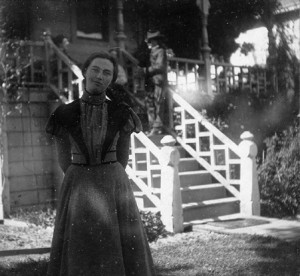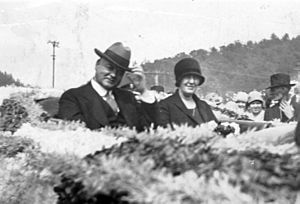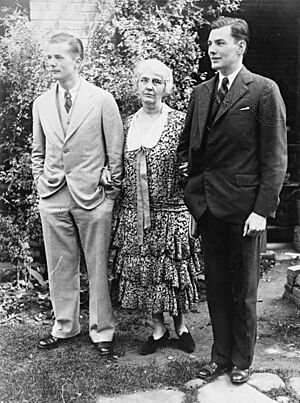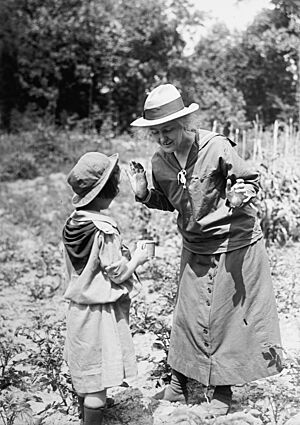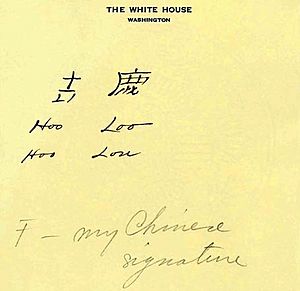Lou Henry Hoover facts for kids
Quick facts for kids
Lou Henry Hoover
|
|
|---|---|
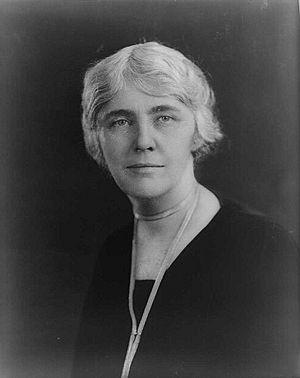 |
|
| First Lady of the United States | |
| In role March 4, 1929 – March 4, 1933 |
|
| President | Herbert Hoover |
| Preceded by | Grace Coolidge |
| Succeeded by | Eleanor Roosevelt |
| Personal details | |
| Born |
Lou Henry
March 29, 1874 Waterloo, Iowa, U.S. |
| Died | January 7, 1944 (aged 69) New York City, New York, U.S. |
| Resting place | Herbert Hoover Presidential Library and Museum |
| Political party | Republican |
| Spouse | |
| Children |
|
| Education | University of California, Los Angeles San José State University (DipEd) Stanford University (BA) |
| Signature | |
Lou Hoover (born Lou Henry; March 29, 1874 – January 7, 1944) was an American who became the First Lady of the United States from 1929 to 1933. She was married to President Herbert Hoover. Lou Hoover was a kind person who loved helping others. She was involved in many groups, like the Girl Scouts of the USA, where she was a leader for several years.
Lou Hoover believed in women's rights and their independence. She was also very good with languages, speaking six of them fluently. She even helped translate a difficult 16th-century book about metallurgy (the science of metals) from Latin into English.
She grew up in California when it was still a wild frontier. She was the first woman to study geology at Stanford University. There, she met Herbert Hoover, who was also studying geology. They got married in 1899. Lou traveled all over the world with Herbert as he worked as a mining engineer. She often helped him with his work.
The Hoovers lived in China for a while. They were there during the Boxer Rebellion, a time of conflict. Later, they moved to London, where Lou raised their two sons. She became a popular hostess, welcoming many guests. During World War I, the Hoovers helped people who had to leave their homes because of the war. Lou organized help for these refugees in the United Kingdom and raised money in the United States.
The family moved to Washington, D.C. when Herbert became head of the Food and Drug Administration. Lou then worked to encourage people to save food. When Herbert Hoover became president in 1929, Lou became First Lady. She preferred to focus on her volunteer work rather than public events. She was the first First Lady to give regular radio talks.
Lou Hoover caused some discussion when she invited Jessie De Priest, an African American woman, to tea at the White House. This showed her support for racial equality. As First Lady, she also worked on fixing up the White House. She helped build a presidential retreat called Rapidan Camp. During the Great Depression, some people thought Lou Hoover didn't care about others. But she was actually doing a lot of secret charity work to help the poor. She believed that helping others should be a private act.
After her husband lost the 1932 election, the Hoovers moved back to California. They later moved to New York City in 1940. Lou was sad about her husband's loss. She continued to help people during World War II until she died suddenly in 1944 from a heart attack.
Contents
Early Life and Education
Lou Henry was born in Waterloo, Iowa. Her father, Charles Delano Henry, was a banker. Lou was the older of two daughters. She grew up in Waterloo, then in California towns like Whittier and Monterey. She was a good student and was expected to become a teacher.
When Lou was a child, her father taught her many outdoor skills. She learned to camp, shoot, and ride horses. She also enjoyed sports like baseball, basketball, and archery. Her parents taught her practical skills too, such as bookkeeping and sewing. Her family was Episcopalian but was also close to the local Quaker community.
Lou started college at the Los Angeles Normal School (now University of California, Los Angeles). She then went to San Jose Normal School (now San José State University), getting a teaching degree in 1893. After graduating, she worked at her father's bank and as a substitute teacher.
In 1894, she heard a lecture by a geologist named John Casper Branner. She was so interested that she joined his geology program at Stanford University. Branner introduced her to Herbert Hoover, who was a senior student. They became good friends, and their friendship grew into a romance. Lou wanted to work in geology, but she couldn't find a job because she was a woman. She was the only female geology student at Stanford at the time. In 1898, she became the first woman to earn a bachelor's degree in geology from Stanford.
Marriage and Travels
Marriage and Life in China
In 1897, Herbert was offered an engineering job in Australia. Before he left, he and Lou informally agreed to get married. While he was in Australia, they kept in touch through letters. He proposed to her by cable, asking, "Going to China via San Francisco. Will you go with me?".
They were married at Lou's family home on February 10, 1899. Lou wanted to become a Quaker like Herbert, but she never officially did. A Spanish Roman Catholic priest performed their civil ceremony at her home.
The day after their wedding, the Hoovers sailed from San Francisco. They had a short honeymoon in Honolulu. On March 8, they arrived in Shanghai. Lou stayed with missionaries in Tientsin (now Tianjin) while Herbert worked. In September, they moved into their own Western-style brick house. This was their first home as a married couple. Lou enjoyed setting up their home, managing staff, and entertaining guests. She also bought a typewriter and wrote scientific articles about Chinese mining with her husband. While in China, she began collecting Chinese porcelain.
The Hoovers lived in China until August 1900. The Boxer Rebellion started while they were there. Despite Herbert's worries, Lou refused to leave him. They were in the Battle of Tientsin in 1900. Lou worked as a nurse, and Herbert was an engineer. Shelling was a constant danger. For a month, Lou carried a revolver and rode her bicycle to deliver supplies to soldiers. As foreigners, they were in great danger. Once, Lou's bicycle tire was shot out while she was riding. A newspaper in Monterey even mistakenly printed her obituary. They briefly returned to China in 1901 with Lou's sister Jean, after the rebellion ended.
Life in London and World War I
After China, the Hoovers moved their main home to London. Herbert became a mining consultant, and his work made them very wealthy. Lou spent a lot of time on steamboats during their travels. They traveled first class, which was comfortable. She spent her time reading or visiting with other travelers. Their work took them all over Europe and to countries like Australia, Japan, and Russia.
The Hoovers had two sons who traveled with them. Herbert Hoover Jr. was born in 1903, and Allan Hoover was born in 1907. Lou was a skilled geologist herself and often helped Herbert with his engineering work. She enjoyed discussing business with him and his colleagues. The Hoovers helped set new standards for the mining industry, especially in how they treated workers and in their business ethics.
In London, Lou often hosted large gatherings. Their home became a social center for other Americans living there. They also often had mining engineers as guests. The Hoovers were very generous. Lou made sure her friends and servants had what they needed. She joined a group called Friends of the Poor to help people in need. She also joined social clubs like the Society of American Women, a group connected to the General Federation of Women's Clubs. She led the society's charity committee.
When World War I began, the Hoovers were planning to move back to the United States. But when war broke out, Lou changed the Society of American Women into a group to help Americans stuck in Britain. The Hoovers stayed in London to provide aid during the war. While Herbert focused on international relief, Lou made sure refugees had food. She raised money and was the only woman on the repatriation board. She traveled between the U.S. and the U.K. several times, despite the dangers of crossing the Atlantic during wartime. For her efforts, King Albert I of Belgium honored her in 1919.
Return to the United States
The Hoovers moved their main home back to the United States in January 1917. Three months later, the U.S. entered World War I. Herbert was made head of the Food and Drug Administration, and they settled in Washington, D.C.. Lou worked with her husband to promote food conservation. The Hoovers became the public faces of this movement. Lou also organized the building of a family home near Stanford University in Palo Alto, California. However, she delayed the project until after the war, as it seemed selfish during wartime.
The war brought many women to Washington to work for the government. Many of these women didn't have much money. So, Lou Hoover started women's groups and provided housing for the women who worked in her husband's department. She also helped these groups get medical care during the Spanish flu. Lou paid for these programs with her own money. She called them "loans" but asked that the money be repaid to someone else who needed it more.
After the war, Herbert became Secretary of Commerce. The family returned to Washington. Lou got involved in new projects, including the Girl Scouts of the USA. She was president of the Girl Scouts from 1922 to 1925. She also started Girl Scout troops in Washington and Palo Alto that included girls of all races. When Calvin Coolidge became president, Lou became good friends with the new First Lady, Grace Coolidge. They started a tradition of exchanging flowers on Easter. Lou also invited Grace to Girl Scout events.
When Herbert was considered for the 1928 presidential election, Lou didn't like active campaigning. Herbert often avoided political talk when she was around. Still, she supported his campaign fully. She traveled with him, using her friendly personality to help his campaign. This election brought more attention to the candidates' wives than before. When Herbert was chosen as the Republican Party's candidate, Lou was often compared to Catherine Smith, the wife of the Democratic candidate Al Smith. Lou Hoover was quite popular. She was seen as athletic and well-traveled, making her a good fit for the role of First Lady. After Herbert won, Lou went with him on a friendly tour of Latin America.
First Lady of the United States

As First Lady, Lou Hoover didn't focus on public appearances. She didn't buy new clothes or learn new skills, which First Ladies often did. She refused to give interviews to reporters and was sometimes seen as distant. However, she was the first First Lady to give regular radio broadcasts. She took pride in these broadcasts, practicing her speeches in a special room. Her talks often used simple language and supported women's rights. She also encouraged her husband to hire more women in his government. She supported a rule to stop sex discrimination in government jobs. Lou continued her work with the Girl Scouts, helping with their organization and money. She generally avoided strong political statements that might cause problems for her husband's government.
Lou Hoover was often private as First Lady. She didn't like having to greet thousands of people at the New Year's Day reception, so she ended it. Her husband later said that only her strong sense of duty stopped her from ending other receptions too. Lou wanted the White House staff to stay out of sight. A bell would ring before she or her husband entered a room, telling staff to leave. When managing White House events, she used hand signals to talk to the staff. Simple gestures, like raising a finger, meant a command. Lou wasn't as good at being a White House hostess as she was at other things. She wasn't eager to be part of Washington society unless it was on her own terms. Her social standing became harder as the Hoovers' reputation suffered during the Great Depression.
When Oscar Stanton De Priest, an African American, was elected to Congress, Lou Hoover invited his wife, Jessie De Priest, to tea at the White House. This was a tradition for the wives of all new Congressmen. Lou carefully planned the event to make sure it went well. She arranged the schedule so only women she trusted would attend. She also told White House security that Mrs. De Priest was expected and should not be stopped. This event became part of a bigger discussion about race. Some Southern voters protested the invitation of a Black woman. This made Lou's relationship with the press more difficult, as she blamed Southern newspapers for the criticism. The Hoovers later invited the Tuskegee Institute choir to the White House, further showing their support for racial equality.
Lou Hoover oversaw the redecorating of the White House. She brought in art and furniture and made a list of all the existing items. She worked with a committee that had been formed earlier, but sometimes she made changes without asking them. She listed the historical furniture in the White House. She also had a movie projector installed. Her work included rebuilding the studies of Abraham Lincoln and James Monroe. These rooms later became the Lincoln Bedroom and the Treaty Room. She also played a key role in designing and building a rustic presidential retreat called Rapidan Camp in Madison County, Virginia. After choosing the location, the Hoovers saw how poor the area was. So, they added a school building to their project. In 1930, they also helped build a Quaker Meeting House in Washington D.C..
As First Lady, Lou Hoover supported the arts, especially young musicians. During the Great Depression, she received many letters from families needing help. She answered many of these letters by sending care packages and personal checks. She also helped them get aid from charities and government groups. She never wanted her charity work to be public, believing that private generosity should not be shown off. She was especially responsible for helping her and Herbert's relatives and friends financially. Lou also helped organize concerts to raise money for the American Red Cross with pianist Ignacy Jan Paderewski. She was deeply hurt by the criticism against her husband during the Great Depression. She was angry that a man she saw as caring was being called uncaring. She joined Herbert on his presidential campaign again in 1932. But they left the White House after he lost the 1932 presidential election.
Later Life and Death
After leaving the White House, the Hoovers took their first real vacation in many years, driving through the Western United States. Lou continued to receive letters asking for help, though fewer than when she was First Lady. In 1935, Lou started a project to buy and restore her husband's birthplace cottage in Iowa.
Lou continued her volunteer work after being First Lady. She returned to the Girl Scouts and served as president again from 1935 to 1937. She went back to Stanford University to help develop its music program. She also supported a physical therapy program, which would be useful if the United States went to war.
Lou Hoover was worried about the actions of the Roosevelt administration. She joined the Pro-America movement, which was against the New Deal. When World War II started, she again worked with her husband to help war refugees, just like they did in World War I. She believed the U.S. should stay out of the war. During the 1940 presidential election, the Hoovers campaigned for Republican candidate Wendell Willkie. The Hoovers moved to New York in December 1940, as Herbert was spending more time there for business.
Lou Hoover died suddenly from a heart attack in New York City on January 7, 1944. Her husband found her dead in her bedroom when he went to kiss her good night. Herbert was heartbroken and never thought about remarrying. After her death, Herbert found hundreds of checks she had received to repay her for her charity work, which she had never cashed.
A joint Episcopalian-Quaker service was held in New York. About a thousand people attended, including two hundred Girl Scouts. A second service was held in Palo Alto, where she was first buried. After Herbert's death in 1964, she was reburied next to him in West Branch, Iowa.
Political Beliefs and Philanthropy
Throughout her life, Lou Hoover supported women's causes. She believed women should have careers in addition to managing their homes. Lou lived by this belief, staying active in her husband's work and her own humanitarian projects. Her support for women started early. She wrote school essays about it. When the Nineteenth Amendment gave women the right to vote in 1920, Lou said women had a duty to be involved in civic life. She was part of several women's groups that helped other women. Lou also supported civil rights for all races and disliked racism. However, she sometimes held common stereotypes of the time and didn't fully understand the problems faced by the African American community.
Lou Hoover strongly believed in helping others and in good business ethics. She supported her husband's decision to pay back his employers after a partner cheated them. She also made sure the cheater's family was financially cared for after he ran away. Lou didn't talk much about her beliefs. She preferred to act quietly. Besides women's issues, she rarely shared her own political ideas, usually agreeing with her husband. She was against publicizing charity work. She gave money to those in need throughout her life without telling others. The full extent of her generosity was only discovered after her death. She felt the same way about religion, believing that actions were more important than belonging to a specific group.
When her husband was head of the Food and Drug Administration, Lou Hoover promoted food conservation. She started a tradition of leaving one chair empty at her dinner table. This was a reminder of children starving around the world. In 1918, she invited reporters to her home for a special "Dining with the Hoovers" interview. She explained her family's eating habits and how they saved food. People started calling the practice of saving food "Hoovering." She gave lessons and recipes to Americans who wanted to grow or prepare their own food.
During the Teapot Dome scandal, Lou Hoover supported government honesty. This scandal led her to call for more women in law enforcement. She led the Women's Conference on Law Enforcement in 1924. As First Lady, Lou indirectly helped disabled veterans of the Bonus Army. However, she believed that able-bodied veterans had no right to the extra money they were asking for. She was very sensitive to political criticism as First Lady. Remarks against her husband's presidency deeply affected her.
Lou Hoover became more conservative after being First Lady. She criticized the Roosevelt administration. Despite their political differences, Lou Hoover has been compared to her successor, Eleanor Roosevelt. They both had similar ways of getting involved in politics and supporting women's issues. Lou Hoover disliked the Roosevelts. She believed they unfairly attacked her husband politically and cost him a second term. She also felt that many of President Roosevelt's actions were against the Constitution. Later in life, she also spoke out against the spread of communism and fascism.
Languages and Translation Work
Lou Hoover loved studying linguistics and foreign languages. She became fluent in six languages as she traveled with her husband. Besides English, she learned Mandarin, Latin, Spanish, German, Italian, and French.
She started learning Mandarin Chinese on the ship to China after her marriage. She had a Chinese Christian scholar teach her. She eventually knew more Chinese words than he did. She sometimes translated for her husband while they lived in China. She continued to practice Chinese with him later so he wouldn't forget the little he knew. When she wanted to talk privately with her husband in the White House, Lou would speak to him in Mandarin. Her Chinese name was 'Hoo Loo' (古鹿; Pinyin: Gǔ Lù【胡潞,Hú Lù】), which sounded like her English name.
She was also very good at Latin, which she studied at Stanford. She worked with her husband to translate Georgius Agricola's De re metallica. This was a 16th-century encyclopedia about mining and metallurgy. Lou was in charge of the language translation. Herbert used his knowledge of mining and did experiments based on the text. This book was thought to be lost because its technical language was so hard to translate. After they translated it, the Hoovers published it themselves. They gave copies to students and mining experts. In 1914, they received a gold medal from the Mining and Metallurgical Society of America for their work. They dedicated the book to Dr. Branner, who introduced Lou to geology and to Herbert.
Legacy and Recognition
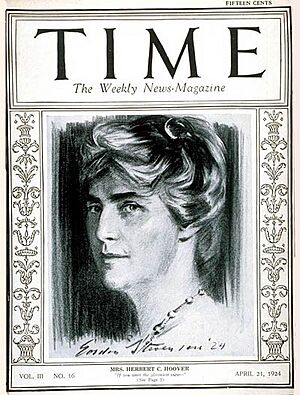
When Lou Hoover was First Lady, she was often shown as a homemaker, which was common for First Ladies. But she was also shown as an activist. Her reputation, like her husband's, suffered when the Hoover administration was criticized for its handling of the Great Depression.
The first book about Lou Hoover was Lou Henry Hoover: Gallant First Lady, written by her friend Helen B. Pryor in 1969. Lou Hoover's personal papers were made public in 1985. This allowed more people to study her life and work. It's hard to study Lou Hoover because she was a very private person. She often avoided media attention and burned personal letters.
Lou Hoover is seen as a balance to her husband. She handled the social parts of their work, both in and out of the White House. Her friendly and graceful manner balanced his reputation for being shy and sometimes proud. There is some debate about the Hoovers' relationship with their staff. Some staff members wrote negative stories, but it's not clear how much of this came from the people who helped them write their books.
The Stanford home that Lou Hoover designed was given to the university by her husband. He asked that it be named the Lou Henry Hoover House. Two elementary schools were named after her: Lou Henry Hoover Elementary School in Whittier, California, in 1938, and Lou Henry Elementary School in Waterloo, Iowa, in 2005. Lou Henry Hoover Memorial Hall was built in 1948 at Whittier College, where she had been a trustee until her death. One of the dorms at San Jose State University was named "Hoover Hall" in her honor until it was taken down in 2016.
Camp Lou Henry Hoover in Middleville, New Jersey, is named for her. It is run by the Heart of New Jersey Council of the Girl Scouts. She paid for the building of the first Girl Scout house in Palo Alto, California. This house is still used today and is called the Lou Henry Hoover Girl Scout House.
See also
 In Spanish: Lou Henry Hoover para niños
In Spanish: Lou Henry Hoover para niños
- Margaret Hoover – Hoover's great-granddaughter



